homepage news
White House defends school guidance for trans students
Earnest says instructions reflect Obama’s views on transgender rights
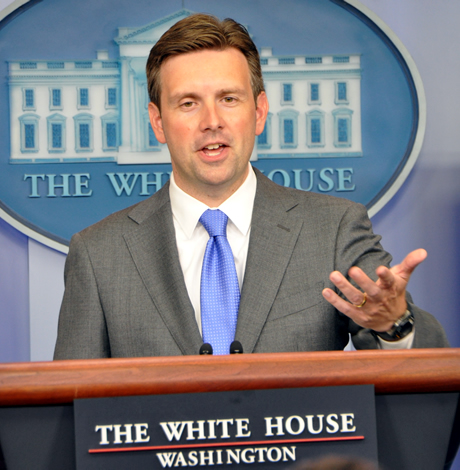
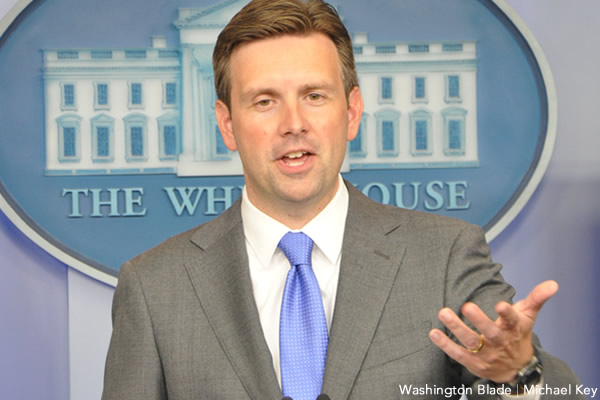
White House Press Secretary Josh Earnest defended the school guidance for transgender students. (Blade photo by Michael Key)
White House Press Secretary Josh Earnest defended on Friday new guidance from the Obama administration requiring schools to allow transgender students to use the restroom consistent with their gender identity, saying it’s meant as “advice” and shouldn’t be considered a threat of loss of federal funds.
“The guidance does not add additional requirements to the applicable law,” Earnest said. “The guidance does not require any student to use shared facilities when schools make alternate arrangements. But what the framework does provide is advice for how school administrators can protect the dignity and safety of every student under their charge. And that advice includes practical, tangible, real-world suggestions to school administrators who have to deal with this issue.”
In response to criticism over the guidance from Lt. Gov. Dan Patrick, who called the instructions federal overreach, Earnest dubbed the official a “a right-wing radio host” turned politician.
Questions on the guidance made up nearly the entire one-hour White House press briefing on Friday, although some reporters asked about funding to confront the Zika virus, immigration raids and other topics.
The guidance was issued one day after Earnest announced the administration won’t cut federal funds from North Carolina over its anti-LGBT law, which prohibits transgender students from using the restroom consistent with their gender identity, as enforcement action of Title VII of the Civil Rights Act against the statute remains ongoing in courts.
Under questioning from the Washington Blade, Earnest denied the administration was sending mixed messages by making that determination and sending on the next day guidance assuring transgender students have access to school bathrooms.
“The situations are quite different,” Earnest said. “I think they do illustrate how consistent and forceful this administration has been about fighting against the idea that people could be discriminated against because of who they are. That’s a principle the President does feel strongly about. It’s obviously a principle that Attorney General Lynch spoke movingly about. And preventing discrimination and treating people fairly is a core principle that does guide a lot of the policy that’s made by the Obama administration.”
Earnest said President Obama was “regularly updated” as the Departments of Education and Justice prepared the guidance and the outcome of those efforts reflects his view.
Asked whether Obama thinks access for transgender students is a civil rights issue, Earnest said the case law is being built up and spoke about ending discrimination.
“But, look, I think the reading of this guidance I think is pretty common-sense,” Earnest said. “You can’t discriminate against people because of their gender identity. You can’t force people with a specific gender identity to use a different facility. That’s discriminating against them.”
The briefing marks the first time a White House official has publicly said the word “transgender” from the podium of the Brady Briefing Room, which Earnest acknowledged during the briefing.
“There was some discussion about whether or not the word ‘transgender’ had ever been uttered from the White House podium before,” Earnest said. “And I think that’s a pretty apt illustration of how this debate is changing and has emerged. So it’s new to our political debate, but this is not new when you consider what school administrators have had to do to ensure the safety and security of every student at their school. This is something that they have to deal with every day.”
President Obama has used the word “transgender” before, most notably in 2015 when he became the first U.S president to say the word — along the words “lesbian” and “bisexual” — during the State of the Union address.
…
A partial transcript of questioning on the guidance during the White House briefing follows:
Josh Earnest: Kathleen, would you like to start?
Q: Sure. Thank you. I’m going to start with the administration’s letter on transgender bathroom guidance for schools.
Earnest: I thought you might.
Q: I thought I’d give you a chance to respond to Texas’s – the lieutenant governor, Dan Patrick, who said that the letter — he called the letter “blackmail,” and said that the administration is doing everything it can to — or he said it’s going to divide the country and it has everything to do with keeping the federal government out of local issues.
Earnest: Well, I think this does underscore the risk of electing a right-wing radio host to a statewide elected office. So let’s just walk through the facts here. The first is, this was guidance that was issued by the Department of Education and the Department of Justice in response to requests for information and guidance from school administrators across the country.
Just last week, for example, the National Association of Secondary School Principals put forward a specific formal request to the Department of Education about how to create the kind of respectful, inclusive environment that school administrators across the country are seeking to maintain. These principals also are interested in making sure that they’re acting consistent with the law. And they sought guidance because they’re not interested in a political argument, they’re actually interested in practical suggestions about how they confront this challenge that they face every day.
So let’s just be clear about what’s included in the guidance. The guidance does not add additional requirements to the applicable law. The guidance does not require any student to use shared facilities when schools make alternate arrangements. But what the framework does provide is advice for how school administrators can protect the dignity and safety of every student under their charge. And that advice includes practical, tangible, real-world suggestions to school administrators who have to deal with this issue. They can’t rely on political arguments that are framed as a solution to a problem that nobody can prove exists. They actually have to deal with the responsibility that they have to promote an inclusive, respectful environment for all of their students.
And what the Department of Education has issued today is specific, tangible, real-world advice and suggestions to school administrators across the country about exactly they can do that.
Q: But you wouldn’t argue — or it seems as though the administration is also trying to paint this as a major civil rights issue, right? This isn’t just a pragmatic sort of everyday guidance to schools. Attorney General Lynch has compared this to racial segregation.
Earnest: Well, I think Attorney General Lynch was talking about a very specific enforcement action that the Department of Education announced — or the Department of Justice announced with regard to a specific law that was passed by the state of North Carolina. In this instance, this is not an enforcement action. As I pointed out, this does not add any additional requirements to any school district or state under the applicable law. This is in response to extensive requests for guidance and for information and advice that have been put forward by school administrators and teachers and, in some cases, even parents who are seeking practical solutions to this challenge.
And the challenge here is not to isolate anybody, it’s not to discriminate against anybody, it’s not to make anybody unsafe — it’s actually to ensure that our schools are as inclusive and respectful and safe as they can possibly be. And that’s why the guidance that we’ve put forward includes tangible, specific suggestions for how that can be achieved.
So let me just give you one example. There are some school districts across the country that have sought to enhance the privacy of their students by making relatively minor changes to shared-use facilities. In some cases, that means just putting up curtains so that people have more privacy when they’re changing their clothes or taking showers in what had previously been shared-use facilities. So that is something that benefits all students, and that’s what we’re looking for — solutions that protect the safety and dignity of every single student in the school.
Q: And if schools individually decide not to follow this guidance, there isn’t a threat that they could lose federal funding —
Earnest: Well, if there are schools — first of all, let me just state that it is my strongly held belief — and I’m pretty sure I’m going to be right about this — that the vast majority of schools and school districts and school administrators across the country will welcome this guidance and will implement it. For those that don’t, there’s an established process for them to raise any concerns that they may have. And there’s an established process for that, and we’ll go through it. But the vast majority of schools and school administrators will incorporate this advice as they confront the challenge of ensuring that they’re promoting the kind of respectful, safe learning environment that can ensure the success of all of their students.
…
Q: On the school bathroom issue, how concerned is the administration about the legal challenges? The Texas attorney general is saying that this oversteps the administration’s constitutional authority. And can you speak to — I mean, you said very clearly to Kathleen that you expect the vast majority of schools will implement the guidance. But for those that don’t, what happens with them? Is the administration actively going to follow up with them and punish them in some way?
Earnest: Well, there’s an established process for schools and the Department of Education to discuss guidance that they’ve been provided. I just want to reiterate — and this is important for people who are interested in the legal aspect of this — there’s no additional requirement under the applicable law that’s being imposed on schools. There’s just not, despite the claims of political opponents of the administration.
There is a strong desire on the part of some politicians to try and score some cheap political points by presenting a solution to a problem that they can’t prove exists. And what the administration has tried to do is to provide, at the request of school administrators, practical, real-world advice they can use in their school communities to address this challenge. That’s the practical offering that we have put forward here.
It’s a lot different than the argument that others are making. For example, is the Texas attorney general suggesting somehow that it would be practical to station a law enforcement officer outside of every public bathroom in an educational facility and check people’s birth certificates on the way in? That doesn’t sound like a practical application to me. It also doesn’t sound like small government to me. It certainly sounds like a government intrusion to me. But, again, that’s what’s hard to sift through in all of this. What exactly is the practical argument or suggestion that they’re making?
I recognize that they’ve got some sharp political arguments that were honed over years of morning drive-time radio in Houston, but school administrators don’t have the benefit of just talking. They actually have a functional responsibility to protect the safety and dignity of every student at their school. And the vast majority of school administrators take that responsibility quite seriously. And I think we’ll welcome and implement the guidance that’s been issued by the Department of Education today.
…
Q: A lot of times when a guidance or regulation or directive comes from a federal agency, it’s portrayed as a White House action. Could you address what this transgender bathroom issue — did this come from the White House? Was the White House consulted? How unitary is the unitary executive on things like this? I guess what I’m asking is, is the White House and the Obama administration synonymous, for all intents and purposes, to —
Earnest: Putting forward guidance like this is the responsibility of the Department of Education. And they have to consider a broad range of policy implications for schools all across the country. So this is the responsibility of the Department of Education, but you would expect the White House to be responsible for coordinating policy decisions that are made by agencies.
So of course the White House was aware of the policy deliberations that have been underway at the Department of Education for quite some time, but ultimately this is the responsibility and the function of the Department of Education, and they are the ones who received requests from schools all across the country, and they are the ones who are putting forward guidance for how schools can deal with this particular situation.
…
Q: What is the rationale that the administration has come to, to base this guidance on Title IX, just to be clear about that?
Earnest: Well, I’m happy to be overruled by an attorney at the Department of Justice or the Department of Education that you can consult after this hearing — or after this briefing, but let me try.
My understanding is that Title IX applies specifically to preventing sex discrimination in educational institutions. And the idea that individuals are discriminated against because of their gender identity is the basis for the guidance that we’re putting forward. Nobody should be discriminated against because of who they are. And our suggestion is that the rules should apply to everybody equally, and that’s the basis of this guidance — that every student should have access to facilities that every other student has access to. No one should be discriminated against because of who they are. And that’s the basis for this guidance.
That’s also why we say no student is forced to use shared facilities. And if there are alternate facilities available, that are made available by administrators, then every student should have access to those as well.
Q: But why shouldn’t local communities be making these very intimate decisions? How does the federal government know what’s best in so many different communities where there are different cultural sensitivities? Why is this not a local matter?
Earnest: It is a local matter. That is exactly the position of the Obama administration.
Q: But why is the federal government involved?
Earnest: The federal government is providing specific suggestions based on examples that we’ve collected from across the country. And the guidance is presented — it is not an additional requirement under the applicable law. It doesn’t provide any obligation to a student, for example, to use a shared facility. Rather, what it does is we have consulted with schools all across the country and surfaced good suggestions, good examples — in some cases, even best practices — for addressing this situation. That’s the essence of guidance that’s at the essence of the coordinating role that the Department of Education plays. At the same time, Ron, there’s a long history in our country of the federal government playing a very important role in ensuring that people aren’t discriminated against.
Q: With regard to the health care law and the new rule, what’s different? How does this apply to the transgender community specifically now? What’s different?
Earnest: So this is a good example of what I was just talking about. There is a new rule that is part of the Affordable Care Act, or the implementation of the Affordable Care Act, that prohibits discrimination based on race, color, national origin, sex, gender identity, age or disability, and it ensures that individuals with limited English proficiency can access language assistance when they’re seeking health care.
Again, a basic responsibility of the federal government — and this has been true throughout our nation’s history — is ensuring that people aren’t discriminated against. And that’s particularly true when it comes to health care as well. And that’s true of any potential sex discrimination, but that also is relevant to discrimination that could be targeted at people because of their race, because of a perceived disability, because somebody is pregnant, because somebody doesn’t speak English very well. We believe people should be treated the same and afforded the same kind of opportunities, regardless of these specific individual characteristics.
Q: Isn’t the mention of transgender patients — isn’t that specific? Isn’t that new? Isn’t that different?
Earnest: All of what I’ve laid out is a new part of the rule that’s been issued today.
Q: What was the harm, in terms of the transgender community? Was there some identifiable problem out there that required this clarification or this augmentation to the rule?
Earnest: Well, again, Ron, this is much broader than just applying to the transgender community. But the transgender community is included. In the same way that we want to prevent discrimination against pregnant women, we want to make sure that we’re preventing discrimination against transgendered women. In the same way that we’re preventing discrimination against people who don’t speak English very well or people who have a specific disability, we want to make sure that transgendered men are not discriminated against either.
Q: Specifically because there’s some concern in that community about access to transition drugs and medications and services, was that something that the administration was concerned about in terms of trying to, I guess you could say, refine this rule?
Earnest: Well, I guess in terms of the way that it has an impact on individual health care decisions, I’d refer you to Health and Human Services for answering that question. But, look, the idea behind this specific rule is to prevent discrimination against a wide range of groups.
…
Q: I had a couple questions on the gender guidelines you sent out last night. Given that North Carolina’s House Bill 2, that’s sort of part of this, is headed to the courts, why did the White House feel the need to put out this directive to the law?
Earnest: Well, this is a directive that is responsive to requests that we’ve received all across the country from school administrators and teachers and parents and others. So this is not a response to the ongoing legal dispute related to HB2. This is a response to requests that the Department of Education has received from teachers and administrators all across the country.
Q: But you’ve cautioned before about being careful of not putting your finger on the scale. Doesn’t this sort of suggest that you’re putting the White House’s finger on the scale?
Earnest: Well, we’ve been quite clear about the need to keep enforcement actions separate from any sort of political interference. This is not an enforcement action. This is a policy decision that was made by the Department of Education. And, yes, the White House was appropriately involved in coordinating that policy decision. But ultimately it’s the responsibility of the Department of Education to make this policy decision and to communicate it to the schools and administrators all across the country.
Notably, it’s not an enforcement action. It does not add a requirement to the applicable law. And it doesn’t pose any requirements on students for the use of shared facilities.
Q: One of the other questions I had for you. You mentioned — you were asked about the lieutenant governor’s comments on it, and you said that it runs the risk — or it underscores the risk of electing a right-wing radio host.
Earnest: To statewide office, yes.
Q: Yes, to statewide office. Yes.
Earnest: Yes. (Laughter.)
Q: Given that the White House last year when the Supreme Court ruled on same-sex marriage, the White House put the lights out on the fountain, how much of this was a political consideration in doing these guidelines.
Earnest: Well, I think as I pointed out before, the guidelines contain practical advice and suggestions for school administrators across the country that have to deal with this challenge inside their communities. They don’t have the luxury of relying on political arguments that are an attempt to try to score some political points that propose to address a solution to a problem that doesn’t actually exist. These are school administrators who are trying to do the right thing. They’re trying to promote an atmosphere of dignity and security for the students and their schools. And so what the Department of Education has put forward are practical suggestions for how exactly they can do that consistent with civil rights law.
Q: And the White House is not looking to score any political points on it, even though it’s been hailed by a number of organizations as a new frontier in same-sex law?
Earnest: Well, I’m not surprised to hear that there are people who agree that we shouldn’t discriminate against people because of who they are. I think most Americans agree with that notion. So that’s part of why I anticipate that school administrators across the country would welcome this guidance.
Look, I’ll also say, I think school administrators across the country who don’t agree with the politics of this administration will also welcome these suggestions, because they recognize that they have a challenge that they have to deal with and that, frankly, they don’t have the luxury of engaging in a partisan political argument with a right-wing radio host. In fact, what they have to do is they have to provide for the safety and dignity of the students who are under their care. And that’s exactly what this guidance does, is it gives them some useful tools for considering a range of options that they can use to do exactly that.
So this has very little to do with politics, except for our critics who want to make this entirely about politics. This administration is interested in providing workable, practical solutions to school administrators who are trying to provide for the safety and dignity of the students under their care.
Q: Josh, is it the intention of the administration that the guidance letter be seen as a threat to deny federal funds to school districts that don’t comply with the policy decisions as interpreted by DOE and DOJ?
Earnest: No, they should not view it that way. They should view this as guidance, as specific suggestions and a framework for dealing with a very straightforward challenge: How do school administrators, all across the country, ensure that they’re protecting both the safety and dignity of every single student at the school. It’s as simple as that. And what the Department of Education has done is they’ve drawn on their own internal expertise, and they’ve drawn on the creative solutions that have been implemented by school administrators all across the country to put all that good information in one place and provide some practical advice to school administrators who are trying to solve this problem. And that’s a good thing.
I think what is true, what is undeniably true is the foundation of this guidance is the principle that people shouldn’t be discriminated against just because of who they are. And school administrators don’t have a glamorous job. These are individuals who, I think in most cases, feel quite passionate about their work. They view their work as a calling. They’re looking to prepare the next generation of Americans to succeed. And they want to create a learning environment where every student can feel safe, where every student can feel included, where every student can feel respected. That’s what the vast majority of school administrators are interested in, and that’s why I think the vast majority of school administrators are going to use this guidance, they’re going to carefully consider the suggestions that have been put forward by the Department of Education, and they’re going to put forward a solution that works in their community. That’s the way this should work.
Q: Could you see how some might see the guidance letter as an implied threat of loss of federal funds, being that you mentioned that under the provisions of Title IX, schools that receive federal funds are obligated to comply with the provisions that are stated forth in the guidance letter?
Earnest: Look, there is a desire in the guidance to be as clear as possible about why this guidance is being issued. But look, it’s quite clear what we’re interested in here. The Department of Education is interested in providing guidance and suggestions to school administrators who are trying to do the right thing. And that right thing is to prevent people from being discriminated against, but also make sure that every single student in their school has their safety and their dignity protected.
Chris.
Q: Thanks. Everyone is in my business today.
Earnest: I know, man. (Laughter.) You got to elbow those people out.
Q: Yesterday, you said that there was a determination, as a result of multiagency review, that there would be no loss of federal funds at this time to North Carolina as a result of possible suit. But at the same time, this guidance on transgender students is issued. Isn’t that sending a mixed message?
Earnest: Well, no, I don’t think it’s a mixed message. I think it’s important for people to understand what’s happening here. This guidance that was put forward by the Department of Education does not impose any new requirements under the applicable law. It’s guidance that’s issued to school administrators in school districts all across the country.
The conversation that we’ve been having over the course of this week has largely been centered on the state of North Carolina and what impact their law could have on their compliance with the Civil Rights Act. So it was related to a specific piece of legislation that was passed almost literally in the dark of night by the legislation that convened a one-day special session to pass this bill. It was signed the same day by the governor. And the rebuke from business leaders in North Carolina and business leaders who are contemplating doing business in North Carolina has been forceful. And I think it’s an indication that the legislation that was passed by the state legislature was much more — was much broader than just something that would apply in an educational setting.
So the situations are quite different. I think they do illustrate how consistent and forceful this administration has been about fighting against the idea that people could be discriminated against because of who they are. That’s a principle the President does feel strongly about. It’s obviously a principle that Attorney General Lynch spoke movingly about. And preventing discrimination and treating people fairly is a core principle that does guide a lot of the policy that’s made by the Obama administration. But the enforcement action that was announced by the Attorney General this week was enforcement action that was the decision of attorneys at the Department of Justice. That decision was not influenced by White House officials. The notification that was distributed by the Department of Education today is not an enforcement action; it was a policy decision that did include some White House involvement, but was the realm and responsibility of the Department of Education.
Q: But nonetheless, given that the major component of House Bill 2 is that transgender students in North Carolina are prohibited from using the restroom consistent with their gender identity, doesn’t that necessarily mean that even if schools not to follow this guidance that the Department of Education has put out, that they will not suffer a loss of federal funds?
Earnest: Well, what this says is — well, the way this works is that if there are schools — and I think they will be in the minority — but if there are schools across the country that do come forward and indicate that they do not intend to be in compliance with this guidance, then there is an established process for litigating those differences with the Department of Education. So there’s an established process for this. We don’t have to invent one.
Q: And was it planned to make the announcement that there would be no loss of federal funds for North Carolina at this time, in conjunction with the announcement from the Department of Education and Justice for this guidance for transgender students? Was that coincidental?
Earnest: No, these were separate actions. So, again, as it relates to North Carolina in consideration of HB2, the policy decision that was made, even as agencies were considering whether or not the passage and implementation of HB2 would put a range of federally funded programs at risk in the state of North Carolina, the decision that was made was to not withhold any funding until the enforcement action that was announced by the Department of Justice had made its way through the courts. So that was a very specific thing, and that was a response to developments that occurred this week with regard to the situation in North Carolina.
This guidance is guidance that has been in the works for years, but it is guidance that is broadly consistent with the kinds of principles that this President and this administration has long fought for.
Q: One last question. Even after you said yesterday, with regard to HB2, that there would be no loss of federal funds to the state as the enforcement action is ongoing in the courts, a Department of Education spokesperson said the review there is ongoing. Do you know why the spokesperson would have said that?
Earnest: I don’t. But this is a little complicated, so it may have just been a bit of a miscommunication. But as it relates specifically to HB2, no federal agencies will be making a decision to withhold funding as a result of HB2 until the DOJ enforcement process has worked its way through the courts.
Q: Josh, is this the extent of guidance like this? Or do you foresee similar directives to come from the administration?
Earnest: It’s certainly possible. I’m not aware of any guidance that’s likely to attract the amount of interest that this one has.
Q: I’m going to go back to an idea you were talking about here with Kathleen. Can you just clarify: Does the President see this as a clear-cut civil rights issue?
Earnest: Well, I think there obviously is a question of civil rights here. And there is a question of how can we ensure that the civil rights of every student is protected. There’s also a question of how do we ensure that the dignity and safety of every student is protected. And the guidance that we have put forward would do both. And again, I think that’s why we’re going to see a lot of school administrators come forward and announce their intent to implement this guidance, or they’re going just going to implement the guidance without announcing it. Or, like many school administrators, they’re already doing this kind of work to ensure the safety and dignity of every student at the school.
And this is the thing that I was mentioning before. This is something that over the last week or two has been a pretty loud part of the political debate. But this is something that school administrators all across the country have been dealing with for quite some time. So they don’t have the luxury of falling back on talking points. They’ve got to implement practical, real-world solutions that make a difference when it comes to the safety and dignity of students at their school. Posting a law enforcement officer outside of every bathroom, and checking the birth certificate of people who are walking through the door — that’s not a practical solution. That’s not going to enhance anybody’s safety. It’s not going to enhance anybody’s dignity. That’s impractical. It’s rooted in a political argument that has very little grounding in actual facts.
So I recognize that that is sort of something that politicians frequently do, which is make arguments that may sound good politically just to score some political points. But to do that at the expense of students all across the country is something I don’t think that they should do.
Q: And the question of civil rights, I mean, are you parsing here that it’s not a civil rights issue? I mean, is this because the courts still haven’t ruled on whether there is protection under the law of transgender persons as a protected class, as an extension of sex discrimination?
Earnest: Well, I think what’s undeniable is this is an issue where case law is still being built up. But, look, I think the reading of this guidance I think is pretty common-sense. You can’t discriminate against people because of their gender identity. You can’t force people with a specific gender identity to use a different facility. That’s discriminating against them.
What we should do is we should treat every student the same. We should protect every student’s safety. We should protect every student’s dignity. We should give every student access to individual-use facilities if that’s what they prefer and they’re available. That’s the cornerstone here of our argument.
Q: You’re saying the case law is still being built up, but you’re not going so far as to say that this is on shaky legal ground because we still haven’t seen the federal protection?
Earnest: I don’t mean to telegraph any lack of confidence in the legal conclusion that’s been reached here. The law is clear. And I think it should be notable that it’s not just the Department of Education that signed on to this, but the Department of Justice has too.
The point that I’m trying to make, Margaret, is that this is something that is relatively new. This is a relatively new policy consideration that school administrators are having to make. This is a relatively new element of our political debate.
I was thinking about Chris earlier today because there was some discussion about whether or not the word “transgender” had ever been uttered from the White House podium before. And I think that’s a pretty apt illustration of how this debate is changing and has emerged. o it’s new to our political debate, but this is not new when you consider what school administrators have had to do to ensure the safety and security of every student at their school. This is something that they have to deal with every day. And that’s why most of them don’t have a lot of tolerance for a bunch of cheap political rhetoric. They’re looking for solutions. And solutions are exactly what were provided by the Department of Education in their letter today.
Q: Thanks, Josh. You’re saying that this is a problem that school administrators are dealing with, but then it was also a problem that didn’t exist until it entered this political realm. How long has the administration been getting questions about this? And did the North Carolina law prompt this guidance or speed its timeline?
Earnest: It did not. This is guidance that had been in the works for years. This is relatively new to our political debate, but again, this is something that has been the source of questions that the Department of Education has received for a number of years now. And again, those questions to the Department of Education were not rooted in the desire of a high school principal to make a political argument. It was rooted in the desire of a high school principal to get some advice and to rely on the experts at the Department of Education to help him or her ensure the safety and dignity of every single student at their school. That’s what these principals are looking for.
Look, in most cases, principals aren’t making a whole lot of money. It’s not a glamorous job. But they do it because they care deeply about our children. They care deeply about providing a good, quality education to our kids. They care deeply about the future of this country. They care deeply about ensuring that a learning environment that they are responsible for managing is one that’s respectful, that’s inclusive, and that is safe. And that’s the kind of guidance that they were seeking from the Department of Education about how best to accomplish those goals.
Q: Doesn’t the administration think, though, or acknowledge at least, that there still is a very difficult process here? For example, the guidance says that when a student or the student’s parent or guardian, as appropriate, notifies the administration that the student will assert a gender identity that differs from their previous representations, the school will begin treating that student consistent with the gender identity. And then it goes on to say the gender transition can happen swiftly or over a long duration of time. If a principal is sitting in front of a student, there could be questions of clarity, sincerity. These are all things that are still not answered and out there, right?
Earnest: Well, I think this goes to Ron’s question. We acknowledge — and, in fact, this is what should happen: School administrators do have to make decisions about the best way to protect the dignity and safety of the students at their school. And, yes, these are complicated issues, and that’s setting aside even the kinds of arrangements that might be available to a school administrator. And so many of our schools are so wildly underfunded, right? So you face this question about are we going to build a new bathroom, or are we going to provide up-to-date textbooks in our science classrooms. These are practical questions that administrators are going to have to answer for themselves.
That’s why it would not be wise for the federal government to be imposing a solution or adding an additional requirement under the law. That’s, in fact, why we have not done that, because we believe in the value and the importance of local control of schools. So we want schools and we want school administrators to be reaching the kinds of conclusions and the kinds of solutions that are in the best interests of that community and that are in the best interests of the students who attend that school.
So that’s also why you’ve seen the U.S. Department of Education draw upon solutions that have been implemented by schools all across the country and surfacing those good ideas and sharing them with other school administrators that are trying to solve the same problem. That’s a pretty high-functioning U.S. Department of Education providing a valuable service to school administrators all across the country that are simply just trying to provide a safe and inclusive learning environment for their kids.
Q: Lastly, the administration has come out very strongly on these issues, with the action against North Carolina, with its guidance today. And those are domestic issues. Internationally, the United States still has relationships with and gives aid to countries that puts LGBT people behind bars, charges them and executes them. Is the U.S. going to exert its influence internationally on this
Earnest: Well, Rich, I would tell you that we do. The President strongly advocates for the rights of all people when he travels around the world. And we certainly have made direct statements — let me say it this way. The President has been crystal-clear both in public settings, but also in private settings, in his conversations with world leaders about our expectation and the priority that we place in this country on human rights.
Q: So we threaten funding?
Earnest: Well, I think that that has been a question that has been discussed in a number of other settings about whether or not significant human rights violations undermine the relationship that the United States has with other countries, or in some cases, could even interrupt funding that is provided by the United States to other countries.
There was an amusing situation a couple of years ago where there were questions about whether or not the United States was going to interrupt the federal aid that we provide to Egypt in the aftermath of a crackdown on political dissidents there. Now, that situation is not funny, but it did provoke an amusing response here as I tried to describe the way that funding is provided to individual countries and tranches, and so some people had some fun with that.
But it underscores that this is a policy priority of the President when he travels around the world. I’ve sat in rooms where the President is talking to world leaders, and the President of the United States respectfully but directly raises concerns about the treatment of minorities in their countries, including the rights of gays and lesbians, and the rights of political dissidents, the rights of women, the rights of journalists. And, look, as a country, these are values that we are deeply invested in and we use our influence around the world to try to advance those values. And the President makes that case rather forcefully, both in public and in private, on American soil and when he’s abroad.
Q: Quickly on the guidance. Do you expect lawsuits?
Earnest: Well, again, what I expect is that the vast majority of school administrators are going to take a look at this guidance and figure out a way to implement it in their schools.
…
Q: On the transgender question, can you help us untangle the President’s role himself? Like did he play a direct role in the guidance? Did he meet with his Attorney General in the last week or recent weeks to discuss this? Did he meet with his Education Secretary in the last week or the week before to discuss this? Did he encourage the issue himself of this guidance? And what in particular might have persuaded him that this was the right thing to do? So can you — a little bit more about what President Obama himself, what role he played in this?
Earnest: What I can tell you about the President is he was he was regularly updated as this policy process moved forward. So he was certainly aware of the policy that was under deliberation by the Department of Education. And I can tell you that the outcome does reflect his view that the Department of Education should be responsive to requests that they’ve received from school administrators and that the Department of Education has an obligation to put forward tangible, real-world suggestions for how this problem can be addressed in communities all across the country.
The President also agrees that imposing an additional requirement under the existing law is not something the Department of Education needs to be doing right now. So it’s possible, and in fact, important for the U.S. Department of Education to play an appropriate role in offering this guidance to school administrators that are trying to enhance the safety and protect the dignity of every student in their community.
Q: The suggestion is that he’s sort of a bystander to this guidance coming out — that it was part of a process, that it came out of the departments, and he didn’t really do much to encourage or discourage, it just sort of happened. Is that an appropriate interpretation? Or did he play a more active role?
Earnest: Well, obviously the President sets a longer-term vision for the priorities that his administration is going to pursue. I can’t speak to all of the conversations that President Obama has had with the Education Secretary about this or other matters. But I think it is fair to say — and I think it’s important — that this kind of announcement reflects the President’s strongly held view about the need to prevent discrimination, but also the need to protect the safety and dignity of every student in America.
So this does reflect the President’s view. But, at the same time, there’s an established policy process for considering these kinds of questions and ensuring that the outcome reflects the priorities that were set by the President of the United States. In this case, they were.
homepage news
Honoring the legacy of New Orleans’ 1973 UpStairs Lounge fire
Why the arson attack that killed 32 gay men still resonates 50 years later

On June 23 of last year, I held the microphone as a gay man in the New Orleans City Council Chamber and related a lost piece of queer history to the seven council members. I told this story to disabuse all New Orleanians of the notion that silence and accommodation, in the face of institutional and official failures, are a path to healing.
The story I related to them began on a typical Sunday night at a second-story bar on the fringe of New Orleans’ French Quarter in 1973, where working-class men would gather around a white baby grand piano and belt out the lyrics to a song that was the anthem of their hidden community, “United We Stand” by the Brotherhood of Man.
“United we stand,” the men would sing together, “divided we fall” — the words epitomizing the ethos of their beloved UpStairs Lounge bar, an egalitarian free space that served as a forerunner to today’s queer safe havens.
Around that piano in the 1970s Deep South, gays and lesbians, white and Black queens, Christians and non-Christians, and even early gender minorities could cast aside the racism, sexism, and homophobia of the times to find acceptance and companionship for a moment.
For regulars, the UpStairs Lounge was a miracle, a small pocket of acceptance in a broader world where their very identities were illegal.
On the Sunday night of June 24, 1973, their voices were silenced in a murderous act of arson that claimed 32 lives and still stands as the deadliest fire in New Orleans history — and the worst mass killing of gays in 20th century America.
As 13 fire companies struggled to douse the inferno, police refused to question the chief suspect, even though gay witnesses identified and brought the soot-covered man to officers idly standing by. This suspect, an internally conflicted gay-for-pay sex worker named Rodger Dale Nunez, had been ejected from the UpStairs Lounge screaming the word “burn” minutes before, but New Orleans police rebuffed the testimony of fire survivors on the street and allowed Nunez to disappear.
As the fire raged, police denigrated the deceased to reporters on the street: “Some thieves hung out there, and you know this was a queer bar.”
For days afterward, the carnage met with official silence. With no local gay political leaders willing to step forward, national Gay Liberation-era figures like Rev. Troy Perry of the Metropolitan Community Church flew in to “help our bereaved brothers and sisters” — and shatter officialdom’s code of silence.
Perry broke local taboos by holding a press conference as an openly gay man. “It’s high time that you people, in New Orleans, Louisiana, got the message and joined the rest of the Union,” Perry said.
Two days later, on June 26, 1973, as families hesitated to step forward to identify their kin in the morgue, UpStairs Lounge owner Phil Esteve stood in his badly charred bar, the air still foul with death. He rebuffed attempts by Perry to turn the fire into a call for visibility and progress for homosexuals.
“This fire had very little to do with the gay movement or with anything gay,” Esteve told a reporter from The Philadelphia Inquirer. “I do not want my bar or this tragedy to be used to further any of their causes.”
Conspicuously, no photos of Esteve appeared in coverage of the UpStairs Lounge fire or its aftermath — and the bar owner also remained silent as he witnessed police looting the ashes of his business.
“Phil said the cash register, juke box, cigarette machine and some wallets had money removed,” recounted Esteve’s friend Bob McAnear, a former U.S. Customs officer. “Phil wouldn’t report it because, if he did, police would never allow him to operate a bar in New Orleans again.”
The next day, gay bar owners, incensed at declining gay bar traffic amid an atmosphere of anxiety, confronted Perry at a clandestine meeting. “How dare you hold your damn news conferences!” one business owner shouted.
Ignoring calls for gay self-censorship, Perry held a 250-person memorial for the fire victims the following Sunday, July 1, culminating in mourners defiantly marching out the front door of a French Quarter church into waiting news cameras. “Reverend Troy Perry awoke several sleeping giants, me being one of them,” recalled Charlene Schneider, a lesbian activist who walked out of that front door with Perry.

Esteve doubted the UpStairs Lounge story’s capacity to rouse gay political fervor. As the coroner buried four of his former patrons anonymously on the edge of town, Esteve quietly collected at least $25,000 in fire insurance proceeds. Less than a year later, he used the money to open another gay bar called the Post Office, where patrons of the UpStairs Lounge — some with visible burn scars — gathered but were discouraged from singing “United We Stand.”
New Orleans cops neglected to question the chief arson suspect and closed the investigation without answers in late August 1973. Gay elites in the city’s power structure began gaslighting the mourners who marched with Perry into the news cameras, casting suspicion on their memories and re-characterizing their moment of liberation as a stunt.
When a local gay journalist asked in April 1977, “Where are the gay activists in New Orleans?,” Esteve responded that there were none, because none were needed. “We don’t feel we’re discriminated against,” Esteve said. “New Orleans gays are different from gays anywhere else… Perhaps there is some correlation between the amount of gay activism in other cities and the degree of police harassment.”

An attitude of nihilism and disavowal descended upon the memory of the UpStairs Lounge victims, goaded by Esteve and fellow gay entrepreneurs who earned their keep via gay patrons drowning their sorrows each night instead of protesting the injustices that kept them drinking.
Into the 1980s, the story of the UpStairs Lounge all but vanished from conversation — with the exception of a few sanctuaries for gay political debate such as the local lesbian bar Charlene’s, run by the activist Charlene Schneider.
By 1988, the 15th anniversary of the fire, the UpStairs Lounge narrative comprised little more than a call for better fire codes and indoor sprinklers. UpStairs Lounge survivor Stewart Butler summed it up: “A tragedy that, as far as I know, no good came of.”
Finally, in 1991, at Stewart Butler and Charlene Schneider’s nudging, the UpStairs Lounge story became aligned with the crusade of liberated gays and lesbians seeking equal rights in Louisiana. The halls of power responded with intermittent progress. The New Orleans City Council, horrified by the story but not yet ready to take its look in the mirror, enacted an anti-discrimination ordinance protecting gays and lesbians in housing, employment, and public accommodations that Dec. 12 — more than 18 years after the fire.
“I believe the fire was the catalyst for the anger to bring us all to the table,” Schneider told The Times-Picayune, a tacit rebuke to Esteve’s strategy of silent accommodation. Even Esteve seemed to change his stance with time, granting a full interview with the first UpStairs Lounge scholar Johnny Townsend sometime around 1989.
Most of the figures in this historic tale are now deceased. What’s left is an enduring story that refused to go gently. The story now echoes around the world — a musical about the UpStairs Lounge fire recently played in Tokyo, translating the gay underworld of the 1973 French Quarter for Japanese audiences.
When I finished my presentation to the City Council last June, I looked up to see the seven council members in tears. Unanimously, they approved a resolution acknowledging the historic failures of city leaders in the wake of the UpStairs Lounge fire.
Council members personally apologized to UpStairs Lounge families and survivors seated in the chamber in a symbolic act that, though it could not bring back those who died, still mattered greatly to those whose pain had been denied, leaving them to grieve alone. At long last, official silence and indifference gave way to heartfelt words of healing.
The way Americans remember the past is an active, ongoing process. Our collective memory is malleable, but it matters because it speaks volumes about our maturity as a people, how we acknowledge the past’s influence in our lives, and how it shapes the examples we set for our youth. Do we grapple with difficult truths, or do we duck accountability by defaulting to nostalgia and bluster? Or worse, do we simply ignore the past until it fades into a black hole of ignorance and indifference?
I believe that a factual retelling of the UpStairs Lounge tragedy — and how, 50 years onward, it became known internationally — resonates beyond our current divides. It reminds queer and non-queer Americans that ignoring the past holds back the present, and that silence is no cure for what ails a participatory nation.
Silence isolates. Silence gaslights and shrouds. It preserves the power structures that scapegoat the disempowered.
Solidarity, on the other hand, unites. Solidarity illuminates a path forward together. Above all, solidarity transforms the downtrodden into a resounding chorus of citizens — in the spirit of voices who once gathered ‘round a white baby grand piano and sang, joyfully and loudly, “United We Stand.”

Robert W. Fieseler is a New Orleans-based journalist and the author of “Tinderbox: the Untold Story of the Up Stairs Lounge Fire and the Rise of Gay Liberation.”
homepage news
New Supreme Court term includes critical LGBTQ case with ‘terrifying’ consequences
Business owner seeks to decline services for same-sex weddings
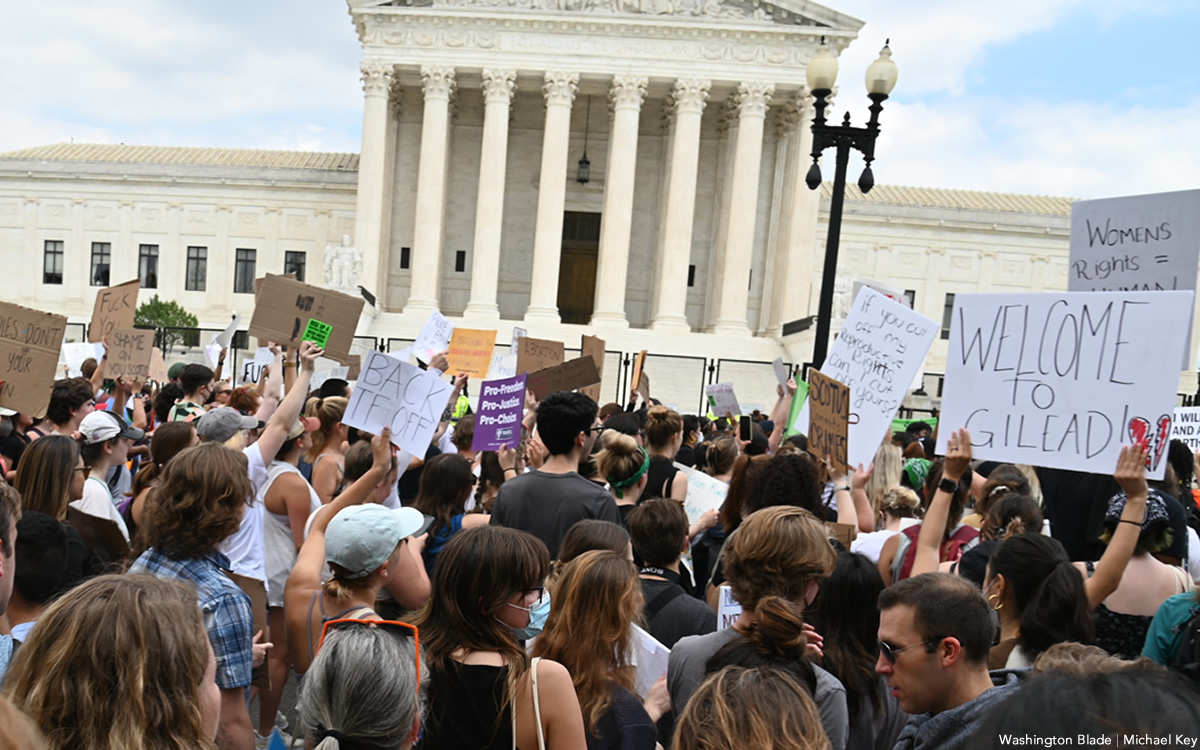
The U.S. Supreme Court, after a decision overturning Roe v. Wade that still leaves many reeling, is starting a new term with justices slated to revisit the issue of LGBTQ rights.
In 303 Creative v. Elenis, the court will return to the issue of whether or not providers of custom-made goods can refuse service to LGBTQ customers on First Amendment grounds. In this case, the business owner is Lorie Smith, a website designer in Colorado who wants to opt out of providing her graphic design services for same-sex weddings despite the civil rights law in her state.
Jennifer Pizer, acting chief legal officer of Lambda Legal, said in an interview with the Blade, “it’s not too much to say an immeasurably huge amount is at stake” for LGBTQ people depending on the outcome of the case.
“This contrived idea that making custom goods, or offering a custom service, somehow tacitly conveys an endorsement of the person — if that were to be accepted, that would be a profound change in the law,” Pizer said. “And the stakes are very high because there are no practical, obvious, principled ways to limit that kind of an exception, and if the law isn’t clear in this regard, then the people who are at risk of experiencing discrimination have no security, no effective protection by having a non-discrimination laws, because at any moment, as one makes their way through the commercial marketplace, you don’t know whether a particular business person is going to refuse to serve you.”
The upcoming arguments and decision in the 303 Creative case mark a return to LGBTQ rights for the Supreme Court, which had no lawsuit to directly address the issue in its previous term, although many argued the Dobbs decision put LGBTQ rights in peril and threatened access to abortion for LGBTQ people.
And yet, the 303 Creative case is similar to other cases the Supreme Court has previously heard on the providers of services seeking the right to deny services based on First Amendment grounds, such as Masterpiece Cakeshop and Fulton v. City of Philadelphia. In both of those cases, however, the court issued narrow rulings on the facts of litigation, declining to issue sweeping rulings either upholding non-discrimination principles or First Amendment exemptions.
Pizer, who signed one of the friend-of-the-court briefs in opposition to 303 Creative, said the case is “similar in the goals” of the Masterpiece Cakeshop litigation on the basis they both seek exemptions to the same non-discrimination law that governs their business, the Colorado Anti-Discrimination Act, or CADA, and seek “to further the social and political argument that they should be free to refuse same-sex couples or LGBTQ people in particular.”
“So there’s the legal goal, and it connects to the social and political goals and in that sense, it’s the same as Masterpiece,” Pizer said. “And so there are multiple problems with it again, as a legal matter, but also as a social matter, because as with the religion argument, it flows from the idea that having something to do with us is endorsing us.”
One difference: the Masterpiece Cakeshop litigation stemmed from an act of refusal of service after owner, Jack Phillips, declined to make a custom-made wedding cake for a same-sex couple for their upcoming wedding. No act of discrimination in the past, however, is present in the 303 Creative case. The owner seeks to put on her website a disclaimer she won’t provide services for same-sex weddings, signaling an intent to discriminate against same-sex couples rather than having done so.
As such, expect issues of standing — whether or not either party is personally aggrieved and able bring to a lawsuit — to be hashed out in arguments as well as whether the litigation is ripe for review as justices consider the case. It’s not hard to see U.S. Chief Justice John Roberts, who has sought to lead the court to reach less sweeping decisions (sometimes successfully, and sometimes in the Dobbs case not successfully) to push for a decision along these lines.
Another key difference: The 303 Creative case hinges on the argument of freedom of speech as opposed to the two-fold argument of freedom of speech and freedom of religious exercise in the Masterpiece Cakeshop litigation. Although 303 Creative requested in its petition to the Supreme Court review of both issues of speech and religion, justices elected only to take up the issue of free speech in granting a writ of certiorari (or agreement to take up a case). Justices also declined to accept another question in the petition request of review of the 1990 precedent in Smith v. Employment Division, which concluded states can enforce neutral generally applicable laws on citizens with religious objections without violating the First Amendment.
Representing 303 Creative in the lawsuit is Alliance Defending Freedom, a law firm that has sought to undermine civil rights laws for LGBTQ people with litigation seeking exemptions based on the First Amendment, such as the Masterpiece Cakeshop case.
Kristen Waggoner, president of Alliance Defending Freedom, wrote in a Sept. 12 legal brief signed by her and other attorneys that a decision in favor of 303 Creative boils down to a clear-cut violation of the First Amendment.
“Colorado and the United States still contend that CADA only regulates sales transactions,” the brief says. “But their cases do not apply because they involve non-expressive activities: selling BBQ, firing employees, restricting school attendance, limiting club memberships, and providing room access. Colorado’s own cases agree that the government may not use public-accommodation laws to affect a commercial actor’s speech.”
Pizer, however, pushed back strongly on the idea a decision in favor of 303 Creative would be as focused as Alliance Defending Freedom purports it would be, arguing it could open the door to widespread discrimination against LGBTQ people.
“One way to put it is art tends to be in the eye of the beholder,” Pizer said. “Is something of a craft, or is it art? I feel like I’m channeling Lily Tomlin. Remember ‘soup and art’? We have had an understanding that whether something is beautiful or not is not the determining factor about whether something is protected as artistic expression. There’s a legal test that recognizes if this is speech, whose speech is it, whose message is it? Would anyone who was hearing the speech or seeing the message understand it to be the message of the customer or of the merchants or craftsmen or business person?”
Despite the implications in the case for LGBTQ rights, 303 Creative may have supporters among LGBTQ people who consider themselves proponents of free speech.
One joint friend-of-the-court brief before the Supreme Court, written by Dale Carpenter, a law professor at Southern Methodist University who’s written in favor of LGBTQ rights, and Eugene Volokh, a First Amendment legal scholar at the University of California, Los Angeles, argues the case is an opportunity to affirm the First Amendment applies to goods and services that are uniquely expressive.
“Distinguishing expressive from non-expressive products in some contexts might be hard, but the Tenth Circuit agreed that Smith’s product does not present a hard case,” the brief says. “Yet that court (and Colorado) declined to recognize any exemption for products constituting speech. The Tenth Circuit has effectively recognized a state interest in subjecting the creation of speech itself to antidiscrimination laws.”
Oral arguments in the case aren’t yet set, but may be announced soon. Set to defend the state of Colorado and enforcement of its non-discrimination law in the case is Colorado Solicitor General Eric Reuel Olson. Just this week, the U.S. Supreme Court announced it would grant the request to the U.S. solicitor general to present arguments before the justices on behalf of the Biden administration.
With a 6-3 conservative majority on the court that has recently scrapped the super-precedent guaranteeing the right to abortion, supporters of LGBTQ rights may think the outcome of the case is all but lost, especially amid widespread fears same-sex marriage would be next on the chopping block. After the U.S. Tenth Circuit Court of Appeals ruled against 303 Creative in the lawsuit, the simple action by the Supreme Court to grant review in the lawsuit suggests they are primed to issue a reversal and rule in favor of the company.
Pizer, acknowledging the call to action issued by LGBTQ groups in the aftermath of the Dobbs decision, conceded the current Supreme Court issuing the ruling in this case is “a terrifying prospect,” but cautioned the issue isn’t so much the makeup of the court but whether or not justices will continue down the path of abolishing case law.
“I think the question that we’re facing with respect to all of the cases or at least many of the cases that are in front of the court right now, is whether this court is going to continue on this radical sort of wrecking ball to the edifice of settled law and seemingly a goal of setting up whole new structures of what our basic legal principles are going to be. Are we going to have another term of that?” Pizer said. “And if so, that’s terrifying.”
homepage news
Kelley Robinson, a Black, queer woman, named president of Human Rights Campaign
Progressive activist a veteran of Planned Parenthood Action Fund
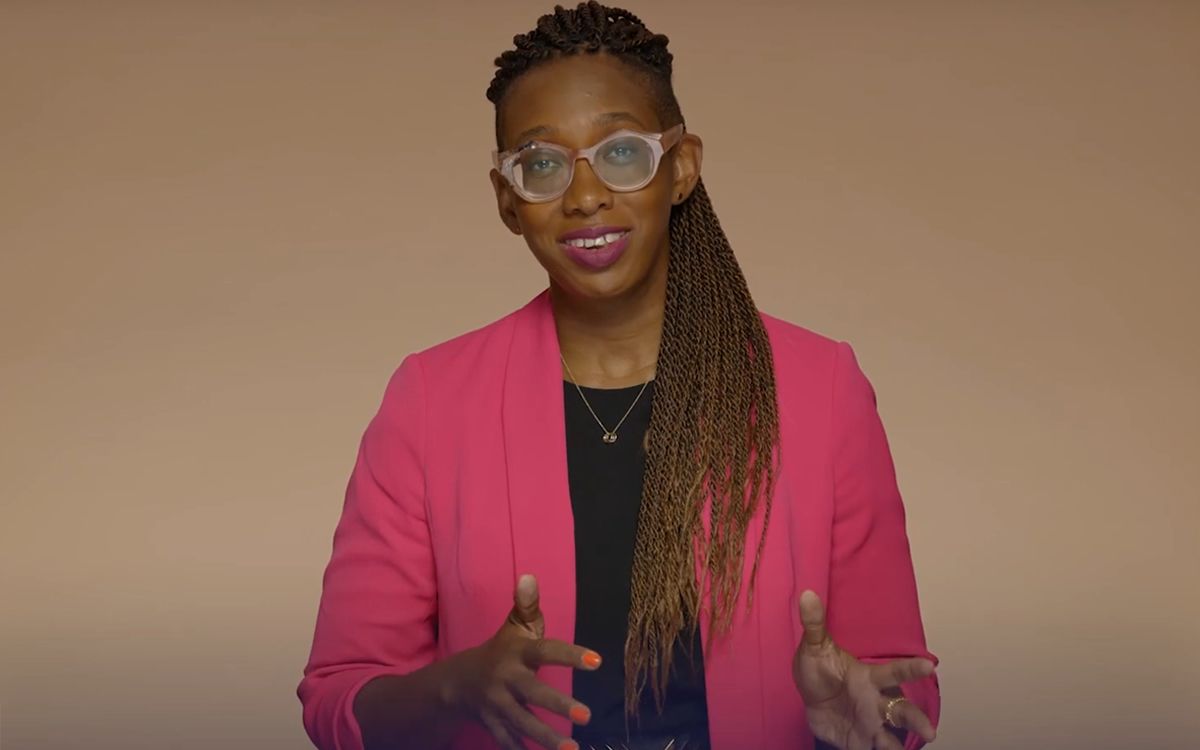
Kelley Robinson, a Black, queer woman and veteran of Planned Parenthood Action Fund, is to become the next president of the Human Rights Campaign, the nation’s leading LGBTQ group announced on Tuesday.
Robinson is set to become the ninth president of the Human Rights Campaign after having served as executive director of Planned Parenthood Action Fund and more than 12 years of experience as a leader in the progressive movement. She’ll be the first Black, queer woman to serve in that role.
“I’m honored and ready to lead HRC — and our more than three million member-advocates — as we continue working to achieve equality and liberation for all Lesbian, Gay, Bisexual, Transgender, and Queer people,” Robinson said. “This is a pivotal moment in our movement for equality for LGBTQ+ people. We, particularly our trans and BIPOC communities, are quite literally in the fight for our lives and facing unprecedented threats that seek to destroy us.”
The next Human Rights Campaign president is named as Democrats are performing well in polls in the mid-term elections after the U.S. Supreme Court overturned Roe v. Wade, leaving an opening for the LGBTQ group to play a key role amid fears LGBTQ rights are next on the chopping block.
“The overturning of Roe v. Wade reminds us we are just one Supreme Court decision away from losing fundamental freedoms including the freedom to marry, voting rights, and privacy,” Robinson said. “We are facing a generational opportunity to rise to these challenges and create real, sustainable change. I believe that working together this change is possible right now. This next chapter of the Human Rights Campaign is about getting to freedom and liberation without any exceptions — and today I am making a promise and commitment to carry this work forward.”
The Human Rights Campaign announces its next president after a nearly year-long search process after the board of directors terminated its former president Alphonso David when he was ensnared in the sexual misconduct scandal that led former New York Gov. Andrew Cuomo to resign. David has denied wrongdoing and filed a lawsuit against the LGBTQ group alleging racial discrimination.
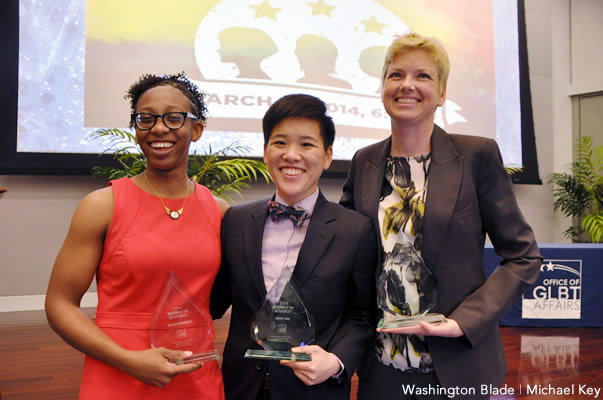
-

 Africa3 days ago
Africa3 days agoCongolese lawmaker introduces anti-homosexuality bill
-

 World3 days ago
World3 days agoOut in the World: LGBTQ news from Europe and Asia
-
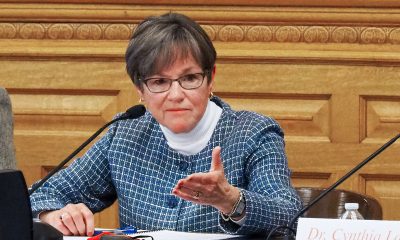
 Kansas5 days ago
Kansas5 days agoKansas governor vetoes ban on health care for transgender youth
-

 District of Columbia3 days ago
District of Columbia3 days agoReenactment of first gay rights picket at White House set for April 17










